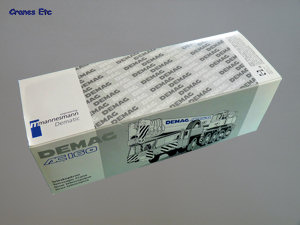 | | Old style Demag box from the pre Terex era. |  |  | | Fly jib is a telescopic lattice. |  | | Underneath detail is sparse. The connected steering axles are visible. | 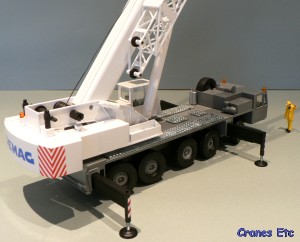 | | The crane has two winch drums although only one hook is supplied. |
| This model is a repaint of the original AC435 model which was produced in a yellow livery with blue writing. It is a 5 axle crane.
Packaging
The model comes in a Demag sleeved box with the model contained in a two-part polystyrene box. The review model was undamaged. No instructions are provided.
Detail
Commencing with the driving cab, a loop is provided for hooking-on during transport mode. Front lights are silvered paint. There are no wing mirrors or windscreen wipers and interior details are basic. The wheels have realistic hubs and the middle (fixed) axle has an appropriately different hub design. The rear of the carrier has an extremely basic shape with a slight raised casting for lights but without paint applied. The top of the carrier has various surface details including footway treads, exhaust pipes and locating points for the counterweight. Orange beacon lights are provided on the driving cab, and the rear of the crane body. A spare tyre fits loosely in a well on the carrier deck.
The crane detailing is relatively basic. Cab details are simple and the only other obvious detailing is an exhaust pipe and a ladder. The jib is a five section telescope. The boom head has plastic pulleys and these are single mouldings representing three sheaves each. There appears to be a problem with the scaling here because the rope cannot pass from pulley to pulley without rubbing on the boom head structure. The fly jib is a two section telescoping lattice which hangs well on the side of the jib during transport. The hook provided with the model is a particularly ugly plastic item. The review model has been fitted with a standard metal hook as shown in the photographs.
Features
The steering has the front and rear pairs of axles linked and this works well. Each steering axle is also mounted on a floating arrangement which provides a form of suspension. The outrigger beams are single stage plastic and have the usual screw action with realistic looking plastic pads.
The counterweight is a single large shaped block which is screwed on through lugs at the rear of the crane body. All the crane actions can be replicated. Two winches are provided, each with a plastic turning handle so it would be possible to run a line off the main boom and fly jib at the same time. The fly jib is also telescopic and attaches to the main boom with the usual pinning system. The pins pass through the axle rod of the boom head pulleys so care has to be taken not to lose the axle rod.
Quality
The paintwork and decals are reasonable although the overall impression is that it is a little more basic than most crane models.
Price
The model was relatively inexpensive for a five axle crane when obtained from the Demag shop.
Overall
This model is a worthwhile addition for the heavy crane collector. However it is a relatively old casting, and in fact the underside is marked 'Made in W Germany'. For this reason it does not really hold its own overall against newer models.
Footnotes
The model was introduced before 1993 as the Demag 435 and was produced in yellow with blue lettering. The blue and white version was sold as a limited 'special' by the Terex Demag shop in 2003.
|
| |
| 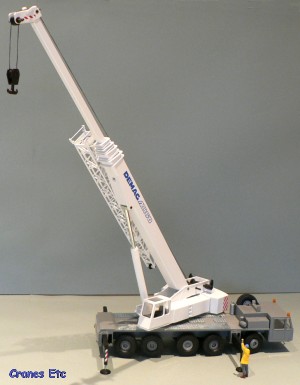 | | Ready to lift. | 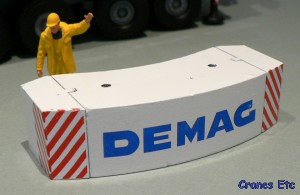 | | The counterweight seems to be made up of three pieces, but on the review model these are inseparable. | 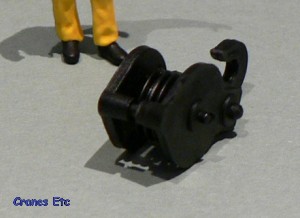 | | 'Why have they sent us this big plastic hook?' |
|

